Nitrous oxide drivers are causing chaos on London's roads
Plus: Did Reform nominate a dead woman for mayor, which big TV series is pretending to be called "Dark Train", and will the Central Line ever get the upgrades it deserves?
If you haven’t tried nitrous oxide yourself, you’ve probably seen the small metal canisters that contained it left in London’s gutters and parks. The drug, also known as laughing gas, has been prevalent in the capital for some time.
What’s changed is that there appears to have been a recent explosion in the number of car drivers causing crashes while inhaling balloons of the gas at the wheel. We’ve spent months looking into the issue, with local community leaders in Tower Hamlets telling us they’re terrified by the rapid growth of the issue and risk to life.
Scroll down to read what’s going on — and learn about the young Londoners turning up at NHS hospitals with neurological conditions following excessive nitrous oxide usage.
We really enjoyed the suggestions in the comments on our last edition about why people feel more willing than in the past to listen to music out loud on our city’s public transport.
All of our journalism is made possible by our paying subscribers. Our pieces take weeks to write and we only publish our journalism when it’s ready— if you’re able to support original, clickbait-free reporting about the capital then we really appreciate it.
If you want to get in touch with London Centric then message us on WhatsApp or email — or click below to leave a comment.
On the hunt for Croydon’s dead mayoral candidate
We were flabbergasted by Inside Croydon’s scoop this week that Reform had selected a dead woman from Bradford to be their local mayoral candidate in south London.
According to the outlet, earlier this year Nigel Farage’s party selected Sharon Carby to run for election in Croydon next year, despite her being deceased for six months at the time. The bio of Carby’s X (formerly Twitter) account, now run by her widower, describes her as an “Anti-woke patriot, Anti-WEF” and declares her love for Nigel Farage, Tommy Robinson, and Donald Trump.
Not so fast, says Reform’s London Assembly member Alex Wilson. He told us that Inside Croydon had “completely fabricated” the “non-story” and “we haven’t selected anyone who’s alive or dead”. Former Croydon and Sutton branch chair Scott Holman also accused the outlet of repeatedly “peddl[ing] lies” and declared his branch’s refusal to engage with its journalists — seemingly something of a habit among Reform politicians.
Inside Croydon’s editor rejects the allegations: “We stand by our sources and our report.” Both Wilson and Holman asserted that prospective candidates would have to be based in Croydon — a requisite curiously absent from the online job advert issued by the party.
Carby’s widower, David, has been hard to track down but appears to have shifted further to the right. He has used his late wife’s X account to label Reform leader Nigel Farage a “delicate snowflake” and urged people to join the new Tommy Robinson-backed alternative to Reform, AdvanceUK. If anyone knows more about this story, do get in touch.
Keep your eyes out for the Dark Train
If you were waiting for a bus on a route past Kings Cross station last weekend, you might have noticed it was on diversion. According to TfL’s journey planner, this was to enable the filming of a television show called “Dark Train”.
Film and TV productions often use codenames to avoid too many nosey passers-by taking an interest and ruining the shoot. These names can be used on applications to local councils or on legal documents required to justify road closures. It’s more unusual for them to be made public.
So the next time you see “Dark Train” as a reason for the delay on the TfL journey planner, you might want to head to the site of the diversion — because it’s the cover name for the potentially-overly-ambitious Harry Potter spin-off TV series.
From “Dark Train” to crumbling trains…
The Central line’s trains are — like many things created in the early 1990s — increasingly tired, unreliable and a hot mess.
The original plan was for them to be entirely replaced by the end of this decade, with the existing trains refurbished in a temporary bodge. After Plan A was scrapped due to central government funding cuts, TfL instead committed to a £500m raft of upgrades on the line’s 85 trains. This involved replacing seats and motors, installing wheelchair bays, and introducing CCTV by 2029.
Now, a freedom of information request by London Centric raises doubts about whether that deadline will even be met. Since the first refurbished train entered service two years ago, only one more has followed. No more upgraded trains have appeared yet this year, although three are set to join the upgraded ranks by early next year, according to TfL.
This leaves a mere 80 trains left to refurbish in the next four years if the target is to be met. After talking to current and former TfL employees in recent weeks, London Centric’s prediction is that the impact of decades of under-investment in the network will become one of the big stories of the next mayoral election.
“The gas and car scene”: How drivers on nitrous oxide are causing chaos on the roads of London
By Rachel Rees
Earlier this year, in the middle of the night, a black Mercedes mounted the central kerb of a busy road near the Blackwall Tunnel, turned ninety degrees, smashed down railings designed to protect pedestrians and blocked the street. The driver fled, abandoning his car on the streets of London. But before he sprinted away, he paused to throw an item he was holding back into the vehicle: an inflated black balloon, suggesting he was potentially inhaling nitrous oxide at the wheel moments before the collision.
The Tower Hamlets incident would fit with a wider trend of drivers using the banned drug in the borough, where one local Bengali social media influencer warned that the “gas and car scene” is out of control. A medical expert described broader use of the drug in the borough as an “epidemic” and said it disproportionately affected the area’s south Asian population.
Nitrous oxide – also known as laughing gas or balloons, due to how users inhale it – has traditionally been associated with music festivals and street corners for its quick, odourless high. Its discarded metal canisters, which can be sold legally on the pretence they are being used to make whipped cream, have been commonplace in the capital for decades, even following its reclassification as a prohibited drug in 2023.
Big Fish, a Bengali TikToker based in Tower Hamlets, told London Centric that use of laughing gas by drivers had “blown up” in the area in the past six months. Nationwide use of the drug by young people had combined with the local “big hire car scene”, he explained – referring to the trend of hiring luxury cars for celebratory events such as prom, Eid, or the ongoing wedding season, particularly among the borough’s South Asian population.
“It’s a celebration drug,” he said, criticising the reckless hedonism of drivers inhaling nitrous oxide at the wheel: “They think they’re Superman”.
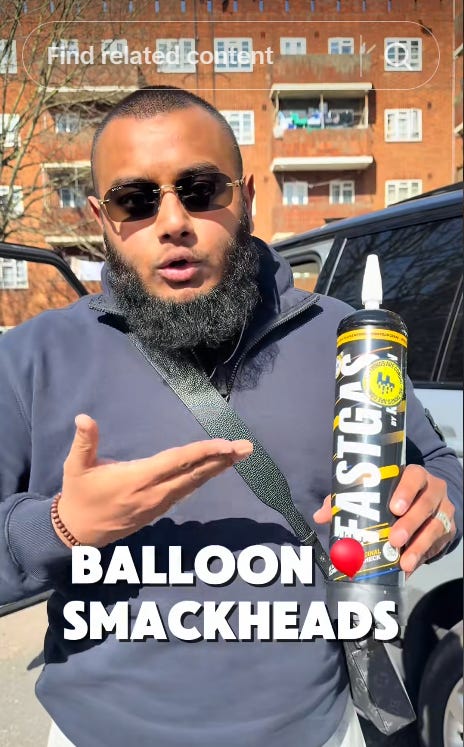
A local mother started a petition urging the council to stop drivers speeding and using balloons, while Instagram account Tower Hamlets Street Vlogs regularly posts footage of drivers allegedly “on loons” for its 28,000 followers. Recent posts show a crashed car with nitrous oxide canisters on the pavement beside it; a driver and passenger running out of a Bentley in the middle of the road in June, the latter holding a balloon; a woman inhaling from a balloon with a pile of canisters beside her in July; a man inhaling from a balloon and gesturing at the camera while driving in broad daylight, in June.
For drivers using the drug, the high might be fleeting but the consequences can be lethal – as evidenced by fatal crashes in Yorkshire in April and Oxfordshire in 2023.
Alastair Noyce, professor of neurology at Queen Mary, University of London, told London Centric that the drug’s “dissociative effect” can make drivers lose complete control of their vehicle, endangering themselves and everyone around them: “Cars are pretty much the most dangerous weapon that any of us are in control of.”
In east London, broader nitrous oxide use has become an “epidemic”, said Noyce, who treats 100 patients a year in the area for spinal cord damage caused by the drug, including bladder and bowel problems. “The effects can be pretty severe, and even permanent,” he added.

Since 2022 around 80% of patients have been South Asian, and the majority of those male, he explained – disproportionately high, even allowing for the area’s demographics. Both Noyce and Big Fish dismissed conjecture that use of the drug might be more prevalent among those who do not drink for religious reasons, saying that users typically also drink alcohol.
Big Fish attributed laughing gas’ popularity to its glamourisation on social media, its short-lived effect, and lack of smell, causing young people to use it frequently and unthinkingly including while driving.
Chief superintendent Marc Clothier, head of the National Police Chiefs’ Council’s drink and drug driving operation, warned that the absence of the social stigma associated with drink driving has allowed drivers using laughing gas to become increasingly normalised.
FastGas is the Mauritius-based manufacturer of many of the nitrous oxide cylinders — used to make “the fluffiest of whipped creams”, according to a page on its website — frequently left discarded on London’s pavements. Its website in June included a picture of a hazy tunnel road, overlaid with the company’s slogan, “go fast or go home”. (When contacted for comment, the company deleted the image.)
The national scale of the issue is hard to fully recognise, despite a couple of high-profile prosecutions, Clothier explained. In police records it might be logged as ‘dangerous driving’ or the broader ‘driving under the influence of drink or drugs’. One key issue is the challenge of police proving drivers have used the drug before road accidents. As a result, as London Centric has found, freedom of information requests for data elicit little success.
But in Tower Hamlets, residents feel the prevalence of the drug among the borough’s drivers is clear.
In June and July, more than 1,000 residents signed a petition criticising the frequent sight of “drivers visibly using nitrous oxide” and other dangerous driving on Roman Road, a major thoroughfare between Bethnal Green and Bow. Mondana Boustani, the Bow resident behind the petition, told local site The Slice she was concerned for her children’s safety.
In 2023, despite the Advisory Council on the Misuse of Drugs’ conclusion that the drug’s overall harms were insufficient to merit banning it, the Conservative government made it illegal to possess or supply for “wrongful use”.
Noyce, the neurologist, said there had been no change in nitrous oxide-related hospital admissions in Tower Hamlets since the 2023 ban, unlike the fall in cases noted by his colleagues in Manchester, Nottingham, and Birmingham. He attributes this to his area’s high deprivation, prevalence of mental health issues, drug supply, and gang culture.
A spokesperson for Tower Hamlets council told London Centric that the authority is working to raise awareness of the risks with workshops for young people, police officers, drug intervention teams, and youth workers.
When told by London Centric about Instagram posts showing drivers using laughing gas, Clothier, the chief superintendent, was appalled: “The fact that people are posting that, it’s quite shocking.”
“Most people know that drink driving is illegal, it’s unacceptable,” he said. “Drug driving, we’re not in that place where it’s seen as socially unacceptable. How do we change that perspective?”
Did you enjoy this edition of London Centric? Please forward it to a friend.
If you want to get in touch with London Centric then message us on WhatsApp or email — or click below to leave a comment.




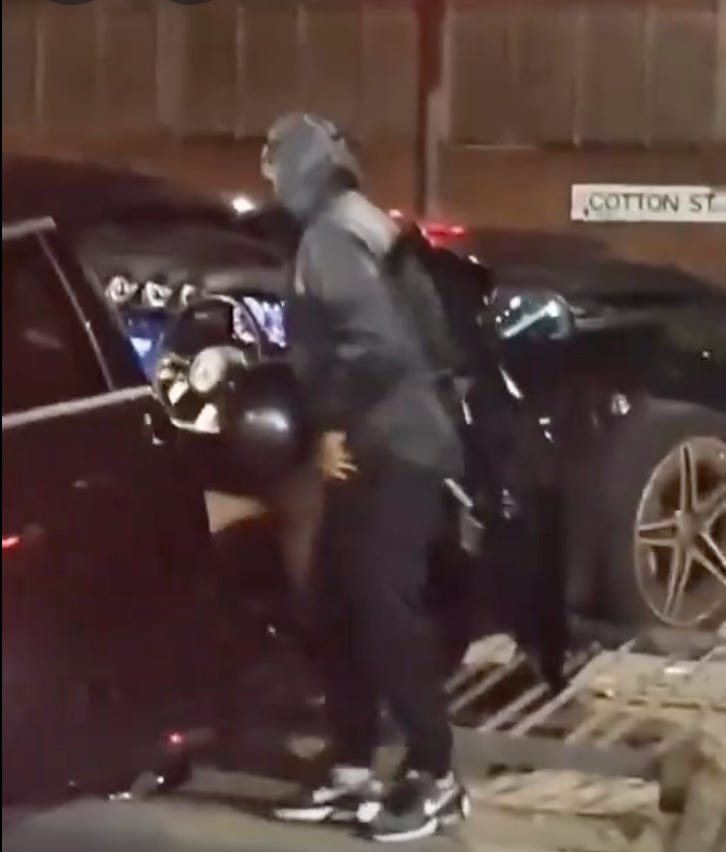
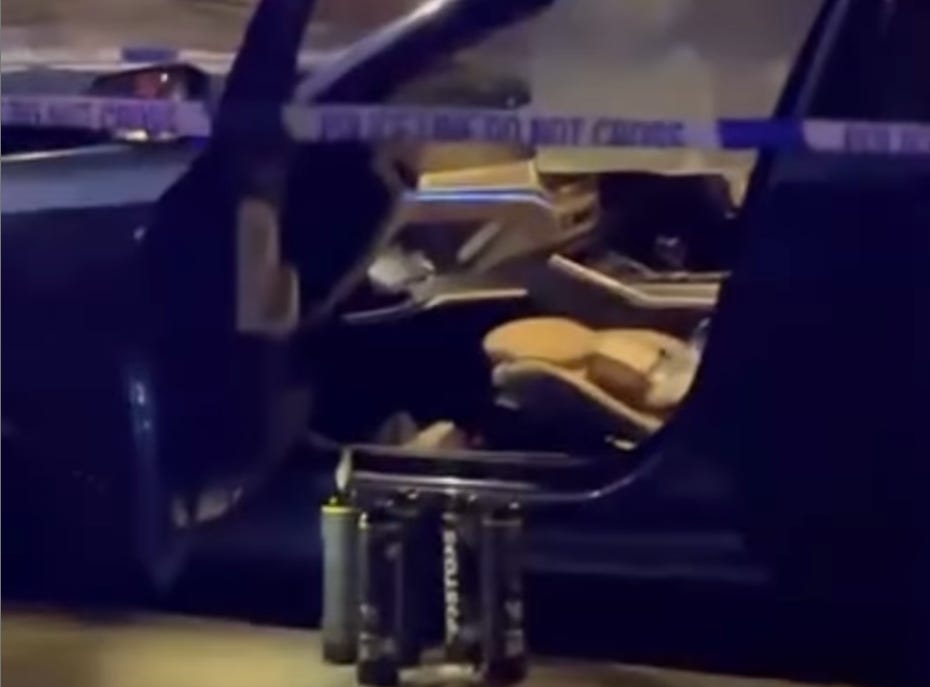
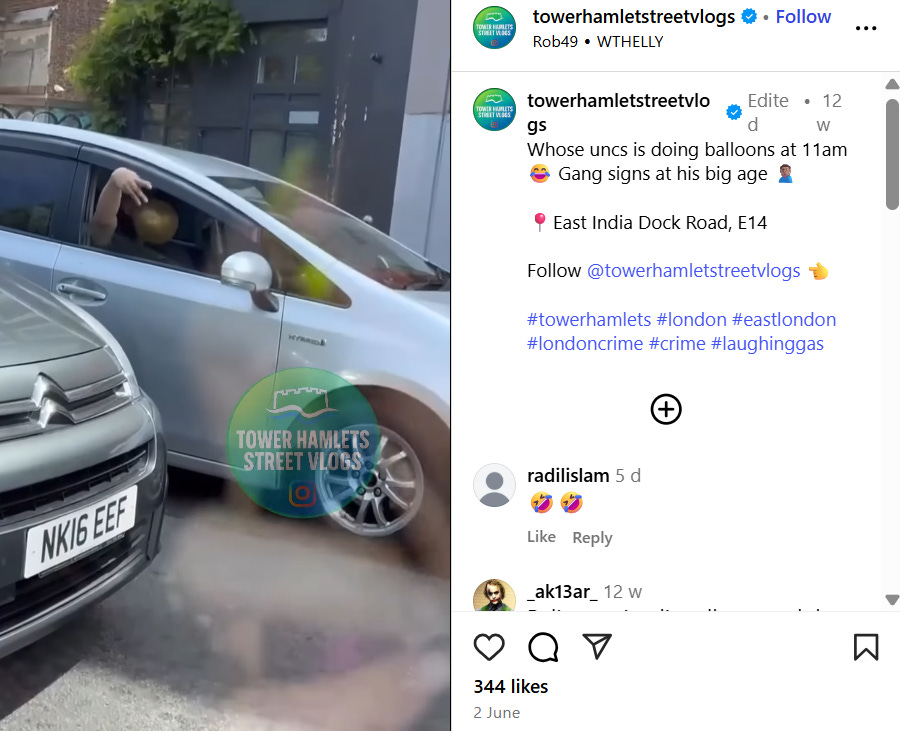
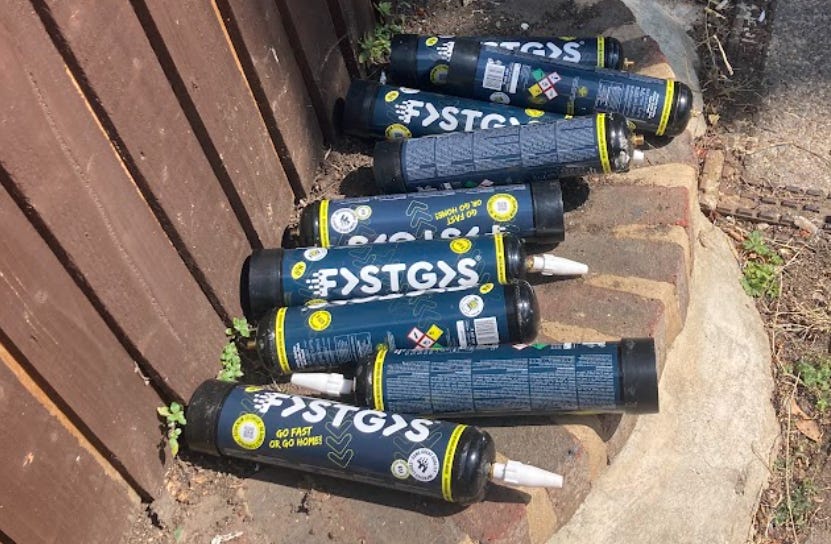

You really do have to be a special kind of loser to have such little regard for the lives of everyone on the road around you.
Excellent reporting as ever. I suspect that the most effective deterrent will be to keep emphasising that they cause incontinence. Nothing like knowing it will lead to you pissing and shitting yourself to deglamourise something.